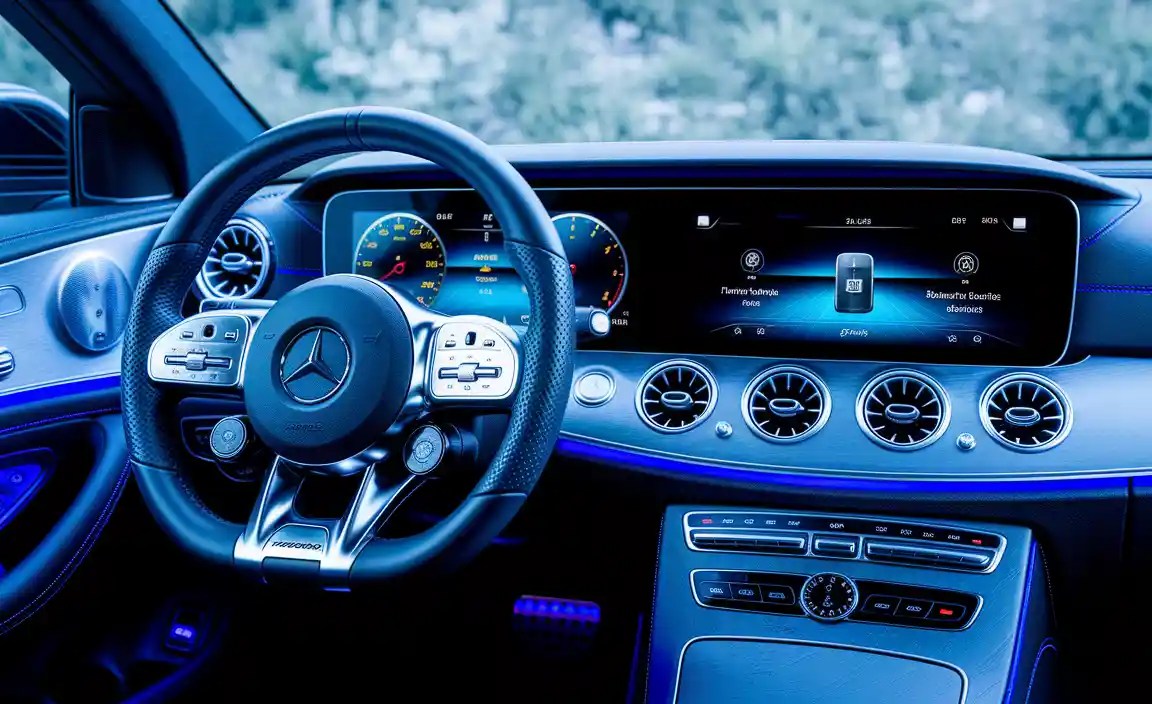B Class Dimensions: Your Perfect Guide
The Mercedes-Benz B-Class offers a compact yet versatile package. Understanding its precise dimensions – length, width, height, wheelbase, and cargo space – is crucial for determining if it fits your lifestyle, garage, and needs. This guide provides a clear, comprehensive breakdown of B-Class dimensions to help you make an informed decision.
Welcome to MercedesBlue! Figuring out if a new car will fit your life can feel like solving a puzzle. We all want to know the exact measurements – will it squeeze into the garage? Can we load up all the gear for that weekend trip? The Mercedes-Benz B-Class is a fantastic choice for those seeking luxury, practicality, and comfort in a compact form. However, sometimes the exact dimensions can be a little tricky to pin down. Don’t worry; we’re here to demystify the B-Class’s size. This guide will walk you through every measurement, from its overall footprint to its internal space, ensuring you have all the information you need. Let’s dive in and discover the perfect fit for you.

Understanding Mercedes-Benz B-Class Dimensions: What You Need to Know

When considering any vehicle, especially a premium compact car like the Mercedes-Benz B-Class, understanding its dimensions is paramount. These measurements are not just numbers on a spec sheet; they dictate how the car will perform, how comfortable it will be for passengers, and how practical it is for everyday use. For the B-Class, a model celebrated for its blend of compact agility and surprising interior space, these details are especially important.
Whether you’re measuring your garage door, planning a road trip, or simply curious about the engineering behind this versatile Mercedes-Benz, grasping the B-Class dimensions allows you to visualize its presence on the road and its capabilities in various scenarios. We’ll break down the key dimensions that matter most to owners and potential buyers.
Exterior Dimensions: The Car’s Footprint

The exterior dimensions define the B-Class’s overall size and how it will fit into your parking spaces and navigate urban environments. These are the numbers that tell you how much physical space the car occupies.
Length
The length of the B-Class directly impacts its maneuverability in tight spots and its stability at higher speeds. A longer wheelbase generally translates to a smoother ride, while a shorter overall length can make parking easier.
The B-Class typically falls into the compact car segment, meaning its length is designed for urban accessibility without sacrificing too much interior room. For the latest generations, you can expect the B-Class to be around 4.4 meters (approximately 174 inches) in length. This makes it comparable to other popular compact hatchbacks and smaller SUVs.
Width
Vehicle width is crucial for assessing how easily the B-Class will fit into garages, parking lots, and alongside other cars on the road. It also influences interior shoulder room.
Standard B-Class models usually measure around 1.8 meters (approximately 71 inches) in width. This measurement typically excludes the side mirrors. When considering parking in confined spaces, always remember to account for the additional width of the mirrors, which can add several inches on each side.
Height
The height of the B-Class is a significant factor, especially if you have low parking garages or plan to transport the vehicle. It also contributes to the car’s interior headroom and its overall profile, often giving it a slightly elevated stance compared to traditional sedans.
The B-Class generally stands about 1.55 meters (approximately 61 inches) tall. This height gives occupants a comfortable seating position and contributes to the vehicle’s practical hatchback design, making entry and exit easier.
Wheelbase
The wheelbase is the distance between the centers of the front and rear wheels. A longer wheelbase generally leads to a more comfortable ride by smoothing out bumps and reduces the vehicle’s tendency to squat or dive under braking and acceleration. It also plays a role in interior legroom.
For most recent B-Class models, the wheelbase is around 2.7 meters (approximately 107 inches). This substantial wheelbase for its class contributes to the B-Class’s surprisingly spacious and stable feel on the road.
Interior Dimensions: Space for You and Your Cargo

While exterior dimensions tell you about the car’s footprint, interior dimensions reveal how spacious and comfortable the cabin is, and how much you can carry. This is where the B-Class often shines, offering more practicality than its compact exterior might suggest.
Passenger Space (Legroom, Headroom, Shoulder Room)
The B-Class is engineered to maximize passenger comfort within its compact frame. Mercedes-Benz pays close attention to ergonomics and space utilization.
- Legroom: Thanks to its efficient design and longer wheelbase, the B-Class offers competitive legroom for both front and rear passengers, making it suitable for longer journeys.
- Headroom: The higher roofline contributes to excellent headroom, ensuring that even taller occupants feel comfortable and unconfined.
- Shoulder Room: While it’s a compact car, thoughtful design choices mean the B-Class provides adequate shoulder room, allowing for a comfortable experience for up to five passengers.
To get a general idea, front legroom is typically around 100 cm (approx. 39.4 inches), with rear legroom often in the 85-90 cm (approx. 33.5-35.4 inches) range. Headroom front and rear usually exceeds 95 cm (approx. 37.4 inches).
Cargo Space (Trunk Volume)
One of the key advantages of the B-Class is its versatility as a hatchback, which translates to impressive cargo capacity. This is where its compact MPV (Multi-Purpose Vehicle) roots often become apparent.
The B-Class typically boasts a trunk volume of around 488 liters (approximately 17.2 cubic feet) with all the rear seats in place. This is substantial for a compact car and ample for groceries, luggage for a weekend getaway, or sports equipment. For even larger items, the rear seats can usually be folded down, dramatically increasing the cargo area to well over 1,500 liters (approximately 53 cubic feet). This adaptability makes the B-Class a practical choice for families, hobbyists, and anyone who needs to transport more than just passengers.
It’s worth noting that specific cargo volumes might vary slightly depending on the B-Class model year and any optional equipment fitted.
Key B-Class Dimensions by Generation

Mercedes-Benz models evolve over time, and dimensions can see subtle adjustments with each new generation. While the core concept of the B-Class as a compact, versatile vehicle remains, these shifts are worth understanding if you’re looking at specific model years.
First Generation (W245: 2005-2011)
The original B-Class was a pioneering model for Mercedes-Benz in the compact segment, featuring a distinctive “sandwich floor” construction that allowed for a more spacious interior and a higher seating position.
Dimensions for the W245 generally included:
- Length: ~4.34 meters (~170.9 inches)
- Width: ~1.79 meters (~70.5 inches)
- Height: ~1.60 meters (~63.0 inches)
- Wheelbase: ~2.76 meters (~108.7 inches)
- Cargo Volume: ~544 liters with rear seats up, expandable to ~2,247 liters with seats folded. (Note: Early models had larger stated capacities).
Second Generation (W246: 2011-2019)
The second generation saw the B-Class become more streamlined and conventionally styled while retaining its focus on interior space and practicality. It also introduced more advanced technology and efficient powertrains.
Typical dimensions for the W246:
- Length: ~4.36 meters (~171.7 inches)
- Width: ~1.79 meters (~70.5 inches)
- Height: ~1.56 meters (~61.4 inches)
- Wheelbase: ~2.70 meters (~106.3 inches)
- Cargo Volume: ~488 liters with rear seats up, expandable to ~1,547 liters with seats folded.
Third Generation (W247: 2019-Present)
The current generation of the B-Class adopts a sleeker, more coupe-like profile, reflecting Mercedes-Benz’s evolving design language. Despite the more dynamic styling, it continues to offer excellent interior space and practicality, often feeling larger than it looks.
Key dimensions for the W247:
| Dimension | Measurement (Metric) | Measurement (Imperial) |
|---|---|---|
| Length | ~4.42 meters | ~174.0 inches |
| Width (excl. mirrors) | ~1.79 meters | ~70.5 inches |
| Height | ~1.56 meters | ~61.4 inches |
| Wheelbase | ~2.73 meters | ~107.5 inches |
| Cargo Volume (seats up) | ~455-488 liters (varies by specification) | ~16.1-17.2 cubic feet |
| Cargo Volume (seats down) | ~1,530 liters | ~54.0 cubic feet |
As you can see, the dimensions have been refined over the years, with the latest generation balancing sporty aesthetics with substantial practicality. For the most precise figures for a specific model year, it’s always best to consult the official Mercedes-Benz specifications for that particular vehicle.
Why B-Class Dimensions Matter for Your Lifestyle
Understanding these figures isn’t just about satisfying curiosity; it directly impacts your ownership experience. Here’s how:
- Garage and Parking: Knowing the exact length and width (even with folded mirrors) is essential for ensuring your B-Class will fit into your garage or designated parking spot at home or at work.
- Urban Navigation: The compact footprint, particularly its width and length, makes the B-Class adept at navigating narrow city streets and fitting into smaller parking spaces.
- Passenger Comfort: Interior dimensions like legroom, headroom, and shoulder room will dictate how comfortable passengers are, especially on longer trips. The B-Class’s design prioritizes this for its segment.
- Cargo Versatility: The cargo volume, especially with the rear seats folded, determines the vehicle’s ability to handle shopping expeditions, holiday luggage, sports equipment, or even moving small items. The hatchback design is a significant advantage here.
- Driving Dynamics: While not solely determined by dimensions, factors like wheelbase contribute to the car’s stability and ride quality. A longer wheelbase usually means a more planted feel on the road.
- Aesthetics and Presence: Dimensions also contribute to the car’s visual appeal and how it looks on the road – whether it appears sleek and sporty or robust and utilitarian.
Comparing the B-Class to Other Mercedes-Benz Models
If you’re considering the B-Class, you might also be looking at other Mercedes-Benz offerings. Let’s see how its dimensions stack up:
- vs. A-Class Sedan/Hatchback: The B-Class is generally taller and offers more interior volume and cargo space than the A-Class sedan or hatchback, leaning more towards practicality and MPV-like versatility. The A-Class is typically lower and more performance-oriented in its styling.
- vs. C-Class Sedan/Wagon: The C-Class is larger overall, particularly in length and wheelbase, offering more legroom and a more substantial road presence. However, the B-Class’s hatchback design can sometimes offer more cargo flexibility for bulky items than a C-Class sedan.
- vs. GLA SUV: The GLA is an SUV-styled crossover. While its exterior dimensions might be similar to the B-Class, the GLA typically offers a higher driving position and often a slightly more rugged aesthetic. Interior space, especially cargo, can be comparable but might differ in configuration.
This comparison highlights the B-Class’s unique position as a compact car that prioritizes interior spaciousness and practicality, often outperforming sportier or more traditionally designed cars in terms of sheer usable volume.
Tips for Measuring Your Space
Before you bring your B-Class home, or if you’re checking potential parking spots, a few simple tips can ensure accuracy:
- Use a reliable tape measure: A standard retractable metal tape measure is best for accuracy.
- Measure the entire length and width: Include any obstructions like pillars or doorways. For width, consider the narrowest point, and remember to add space for opening doors.
- Check vertical clearance: Measure the lowest point of any overhang (like garage doors) to ensure sufficient height.
- Factor in turning radius: For very tight parking situations, consider not just static dimensions but also how much space you need to maneuver. You can find the turning circle diameter (usually around 11 meters for the B-Class) in the vehicle’s technical specifications.
- Visualize with a digital tool: Some online car configurators or dealership VR tools can give you a good sense of scale.
Frequently Asked Questions (FAQ) about B-Class Dimensions
What is the overall length of a Mercedes-Benz B-Class?
The length of the Mercedes-Benz B-Class typically ranges from approximately 4.42 meters (174 inches) for the current generation (W247) down to around 4.34 meters (171 inches) for older generations. This compact length makes it easy to maneuver in urban environments.
How wide is the B-Class, and will it fit in my garage?
The width of the B-Class (excluding mirrors) is generally around 1.79 meters (70.5 inches). Most standard garage doors are wider than this, but always measure your specific garage opening, remembering to account for the additional width of the side mirrors when maneuvering, which can add up to 10-20 inches total.
What is the cargo capacity of the B-Class?
The B-Class offers excellent cargo versatility. With the rear seats up, the trunk volume is usually between 455 to 488 liters (16.1 to 17.2 cubic feet). When you fold down the rear seats, this expands significantly to over 1,500 liters (around 54 cubic feet), making it capable of carrying larger items.
Is the B-Class taller than a typical sedan or hatchback?
Yes, the B-Class is generally taller than most sedans and some hatchbacks. Its height is typically around 1.56 meters (61.4 inches), which contributes to its more upright seating position, easier entry and exit, and increased headroom.
How does the B-Class wheelbase affect its ride?
The Mercedes-Benz B-Class features a relatively long wheelbase for its class, usually around 2.7 to 2.76 meters (107-108 inches). A longer wheelbase generally results in a more stable and comfortable ride by better absorbing road imperfections and reducing pitching motions.
Can five adults comfortably fit in a B-Class?
For a compact car, the B-Class is known for its spacious interior. While five adults can fit, the rear middle seat might be more comfortable for shorter journeys or for children. The generous headroom and decent legroom for the outboard rear passengers make it a good option for families.
What is the ground clearance of the B-Class?
The ground clearance for the B-Class is typically around 12-15 cm (approximately 4.7-5.9 inches). This is standard for compact cars and hatchbacks, suitable for paved roads and general urban driving. It means the B-Class is not designed for significant off-road use.
Conclusion
The Mercedes-Benz B-Class consistently proves that compact doesn’t mean compromising on space or practicality. By understanding its specific dimensions – from its precise length and width that make it a master of urban manoeuvrability, to its impressive height and wheelbase that contribute to a comfortable and stable ride, and most importantly, its remarkably versatile interior and cargo space – you can confidently determine if it’s the perfect fit for your garage, your commute, and your lifestyle.
Whether you’re hauling groceries, embarking on a weekend adventure, or simply navigating the daily grind, the B-Class dimensions are engineered to deliver a premium, functional experience. We hope this guide has provided all the clarity you need to appreciate the intelligent packaging of this exceptional Mercedes-Benz model.






